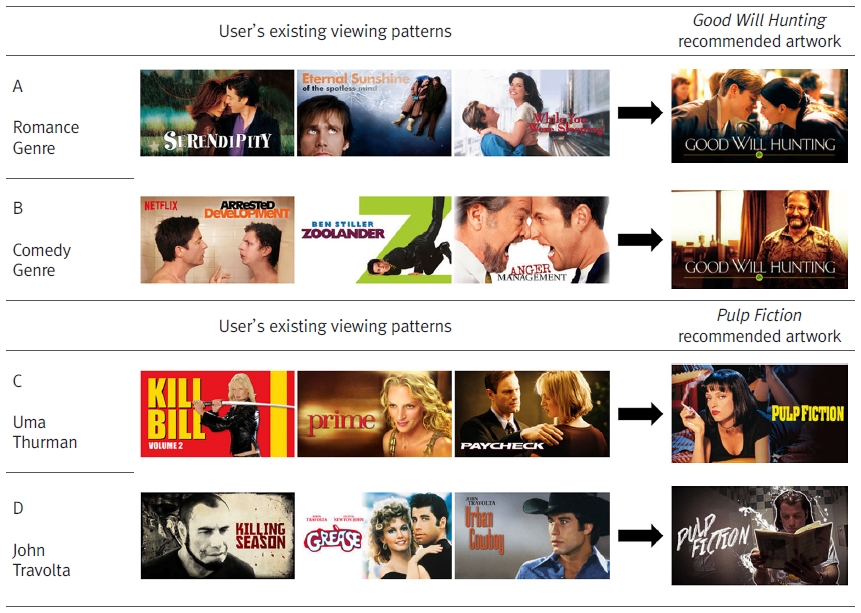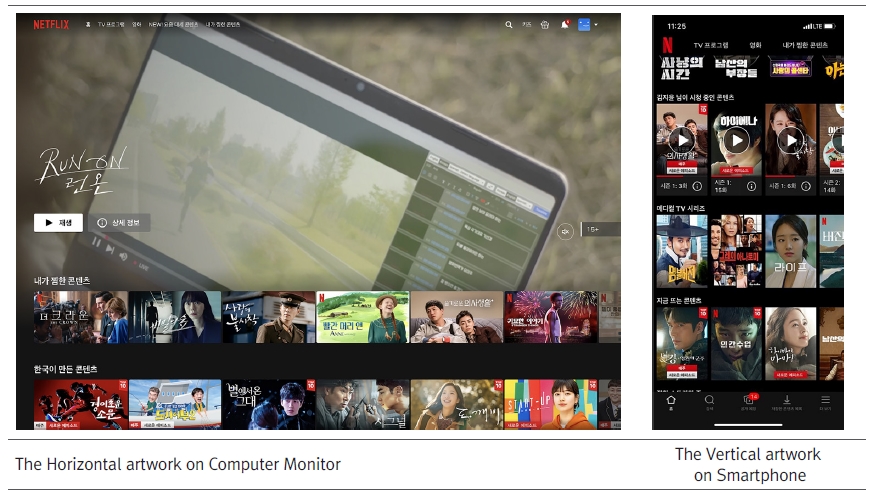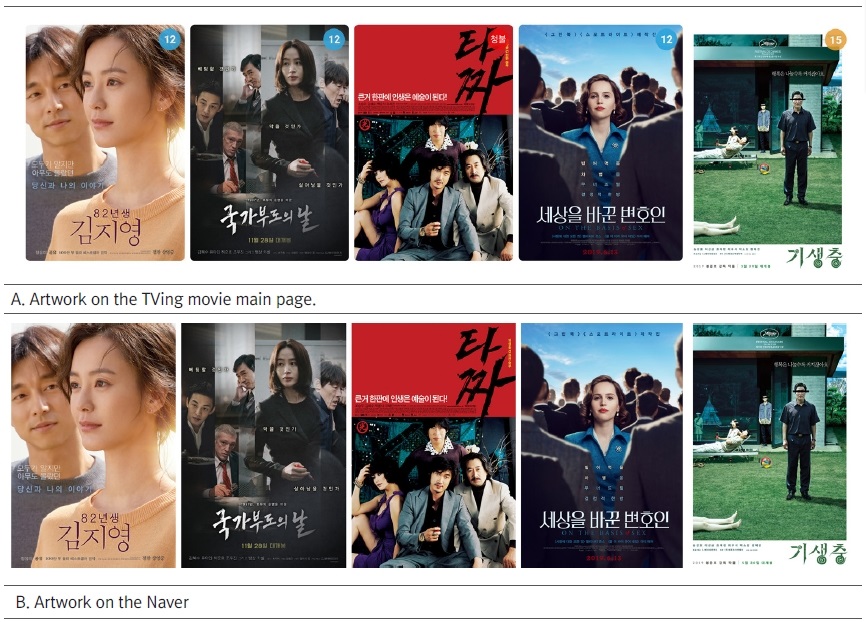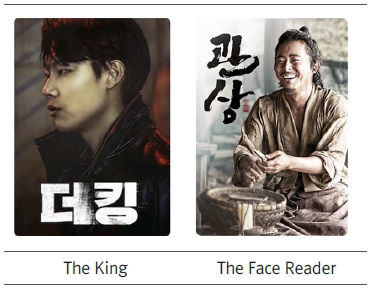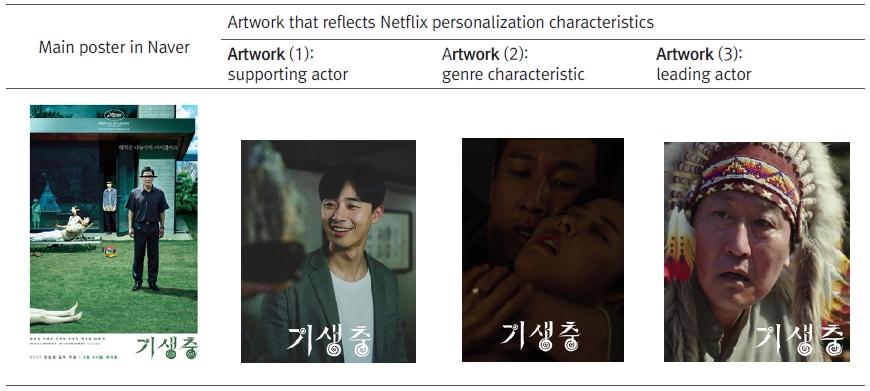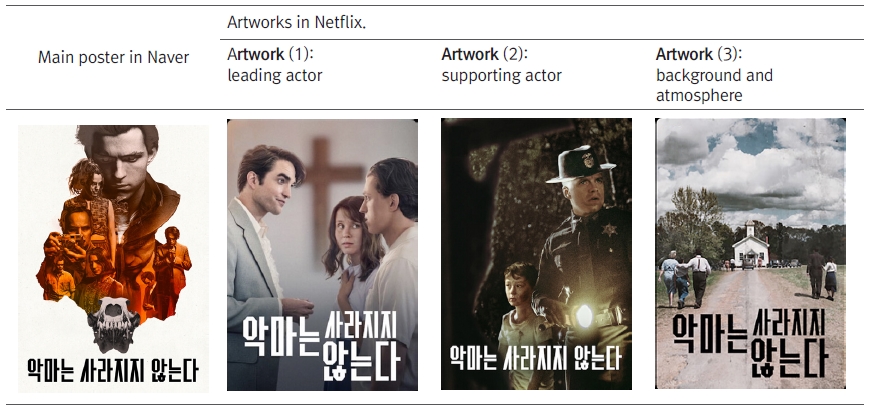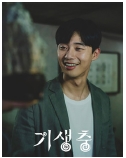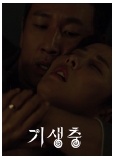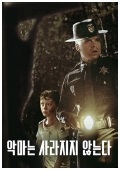
Between Familiarity and Unfamiliarity : Users' Perception and Intention of Watching Netflix Artwork
Abstract
Background Personalization service through AI and ML (machine learning) plays a significant role in the success of Netflix. Netflix's personalized recommendation service is not only applied to the content but also to Netflix artworks. The first thing users encounter when choosing content at the OTT service platform is artwork. Users explore and formulate choices with the artwork. The artwork is the first impression to attract users and an important factor affecting the decision what to watch. This study seeks to determine viewer’s perception and intention of watching of Netflix's personalized artwork. We speculatedwondered whether Netflix artwork's personalization replaces the movie poster's image too familiar to attract attention or if it overlooks the anchoring and the primacy effect's benefits.
Methods We hypothesized and surveyed whether there is a difference in viewing intention according to the type of artwork. In addition, we set a hypothesis to see if the more we accept personalized artwork as positive and negative unfamiliarity, the more it affects the viewing intention. We chose Parasite, which is well known to the public and The Devil All the Time as a less well-known content. To answer these hypotheses, we surveyed a total of 152 respondents. The results of the survey were statistically verified through one-way analysis of variance and simple regression.
Results For Parasite, the main poster type's artwork derives users' intention of watching by anchoring effect and primacy effect. On the other hand, personalized artwork produced by converting genres or focusing on supporting actors negatively affected their intention of watching. Meanwhile, for The Devil All the Time, the main poster was less known to users in Korea. Therefore, there was little anchoring and primacy effect since users did not recognize the main poster as representative images of the movie. In this case, not only the main poster type, but also the artwork with the leading actor's image, and the artwork with the overall atmosphere of the movie can draw the users' intention of watching. In both films, the more the respondents felt the negative unfamiliarity of the artwork that gives them the impression that the movie seems like a formula film, the less intention of watching.
Conclusions It was revealed that personalized artworks do not only attract viewers' positive perceptions and can interfere with the viewer's intention to watch. Based on this, it is expected that the study will help to produce artwork for the OTT service.
Keywords:
Personalized Artworks of Movie, Positive Unfamiliarity, Negative Unfamiliarity, Intention to Watch1. Research background and purpose
Through the era of watching movies on television and in theatres, now the Internet-based Over-the-Top (OTT) service that allows users to watch movies anytime, anywhere has established itself. There are already too many OTT companies, including Netflix, Amazon Prime Video, Youtube, Disney+ and Apple+, as well as domestic services such as TVing and Wavve. Therefore, competition between companies intensified. According to the World Economic Forum (2021), Netflix has the largest number of global subscribers, with more than 200 million across 190 countries. Netflix's share is also expanding rapidly in Korea. According to the Nielson Korean Click website(2021), Netflix's monthly active users are about 6.5 million, larger than the combined users of Wave and TVing, which are the two primacy OTT services in Korea.
Personalization service through AI and ML (machine learning) plays a significant role in the success of Netflix. According to Lee(2020), Netflix provides personalized services by mixing more than 100 different algorithms. When users choose the content, about 80% of their choice followed Netflix's recommendations. Netflix's personalized recommendation service is not only applied to the content but also to Netflix homepage UI and artworks. Chandrashekar et al.(2017) said that Netflix's artwork is also personalized to suit users' content tastes. Netflix's artwork is a still image representing content called thumbnail in South Korea. Chandrashekar et al. (2017) said that artwork also changes depending on the content genres that users usually watch and the actors who usually appear in the content they watch. Lee(2020) mentioned that Netflix users watch an average of 1.8 seconds per artwork. If they cannot decide on what to watch in 90 seconds, they usually leave Netflix. If users fail to choose while searching for content, they will not use Netflix, and if this situation repeats, the possibility of cancelling the subscription will be higher. In other words, the first thing users encounter when choosing content at the OTT service platform is artwork, and they explore and make choices with it. The artwork is the first impression to attract users and an important factor affecting the decision what to watch.
Nevertheless, there is still little academic research on the components and effects of Netflix's artwork. Most of the Netflix-related research has been on user satisfaction with recommended content, user experience, and recommendation algorithm analysis. (Son and Choe 2019; Noh 2018; Choi and Ko 2018; Kim 2019; Chung 2014) Personalized artwork images have been overlooked despite their importance as the elements of contents exploration and selection. Therefore, this study gropes how users recognize the artwork and how the perception influences the choice as exploring and selecting contents.
2. Personalized Artwork of Netflix and Case Study
On The Netflix Tech Blog, Chandrashekar et al.(2017) described Netflix's personalized artwork as follows, using the movie Goodwill Hunting as an example. (Figure 1) Netflix might personalize artwork based on how much a user prefers different genres and themes. Someone who has watched many romantic movies may be interested in Good Will Hunting if we show the artwork containing Matt Damon and Minnie Driver, whereas a member who has watched many comedies might be drawn to the movie if we use the artwork containing Robin Williams, a well-known comedian.
Artwork changes not only depending on the genre but also on preferences for cast members. In the case of the artwork of the movie Pulp Fiction, starring Uma Thurman and John Travolta, a user who watched much content starring Uma Thurman can see the artwork featuring Uma Thurman. Moreover, a user who watched much content starring John Travolta can see John Travolta on it.
Chandrashekar et al.(2017) said, Netflix has more than 100 million personalized artworks. According to an interview with a person in charge of creativity at Netflix, June 1, 2020, each content has about 100 artworks. Three design companies have produced artworks in Korea. A total of 40 artworks are usually produced with 20 vertical and 20 horizontal layouts per content. Of course, there are differences in the number of artworks depending on the budget. The types of the artwork on the main page of Netflix also vary depending on the devices. As in Figure 2, users can see horizontal artworks on their computer monitor screen, but they may see vertical artworks on their smartphone. Considering the Netflix Tech Blog and interview, it seems that there are about 20 types of recommendation algorithms such as genre, specific actor, and actor's primacy acting genre.
It is different from other OTT services in South Korea. In the case of TVing and Wavve, Korea's leading OTT services, images (thumbnails) equivalent to Netflix's artwork are not personalized. Looking at Figure 3, A is the artwork of movies on the main page of TVing. B is a movie poster image that appears when searching that movie through Naver, a typical Korean portal site. The artworks of these media are the same as each other.
3. Prior Research and Hypothesis Setting
According to Kim et al. (2011) in Korea JoongAng Daily, Korean films' marketing costs account for 35 % of the total production budget. While the US spends 30% of its marketing costs on TV and newspaper advertising, South Korea uses 20% of it on portal advertising, accounting for the most significant portion of total marketing cost. Therefore, it is typical for representative images of a particular movie to match those of portal sites. The artwork of Figure 3 on Naver portal (B) is the main poster for each film. According to 2020 data from the Korea Film Council, about 70% of domestic consumers get information about movies through portal sites and their neighbours' recommendations over the past five years. TV, social media, and movie posters were second-tier sources of film information. Therefore, domestic consumers have no choice but to recognize the main poster image as the representative one, which can serve as an anchor.
The anchoring effect refers to a particular value as an anchor point (Kahneman, 2011; Jacowitz, Karen, and Kahneman, 1995). It is a phenomenon in which an impressive number or object becomes an anchor point, distorting judgment and biased influence, just as a ship can only move within the rope's range that connects the anchor to the ship. If this applies to Netflix artwork, this means that images shown by personalized recommendations may cause biased choice. According to Jacoby et al.(1989), people could easily recognize words they saw once. Therefore, people recognized the words they saw before faster and easier than the words first shown even though they appeared simultaneously. People feel familiar with the words they saw before because it is very easy for them to recognize. Then, can viewers recognize and feel familiar with the movie posters they have seen before? Of course, Jacoby's experiment was on words experiment and not on images.
This phenomenon can also describe as the primacy effect. The primacy effect refers to a phenomenon in which information presented first is recalled better than information presented later. Since domestic consumers were exposed firstly to the main poster when the movie was released, they remember the main poster as a representative image. For this reason, the items presented later are interfered with the items initially presented when the memory is retrieved. According to Lee (2016), it is also called concrete law, meaning that the first image could be easily solidified. The primacy effects are being revealed in video and advertising research. In sports advertising, Kwon and Choi(2019) said that the first sports event to be exposed was more memorable. In the news, Choi(2008) said that the scene placed in the front of the broadcast news had a more significant impact on viewers. Also, in motion infographics, Han and Kim(2020) said that when the preview strategy applies to the motion graphic promoting the government's public policy, it was more memorable because of the primacy effect. In those cases, we also looked at the question from the artistic side whether only the thing people are familiar with and they saw before catches their eyes, too. According to Flickinger(2011), unfamiliarity coined by Russian formalist, Viktor Shklovsky is an artistic technique that makes familiar objects unfamiliar and makes them free from the indifference of automated perception. It makes people interested in objects that are too familiar to attract attention. For ordinary things to look extraordinary, they should be presented anew away from the familiar context. Jin(2014) mentioned that surrealists liked to take things from their original places and relocate them out of context. Things are felt unfamiliar and get paid attention to when they are out of the original context. Netflix's artwork provides unfamiliar images that have never been seen before by personalization. As seen in Figure 1, personalized Netflix artworks emphasized certain leading actors like Pulp Fiction and highlighted the romance of male and female characters like Goodwill Hunting distorted the genre. It also features supporting actors who are not the leading actors like the Korea films The King or The Face Reader in Figure 4.
Even after the movie ends in theaters, it can have second-run airing on OTT services, so viewers can watch movies regardless of the production or release time. So, movies with the same title and similar titles are also mixed in OTT service.
In terms of legal rights and originality, there should be only one title in the world, but in reality it is not. The same title and similar titles are being made over and over again. In some cases, the title of a movie from decades ago is borrowed. Movies produced around the same time also often have the same title as in Figure 5. For movie Mother, more than 20 movies of the same name were searched on Naver Movies, a portal site. Among them three movies have been serviced on Netflix.
It is easy for people to remember the title and actors information of a movie that is in the midst of promotion, but it is not easy to remember accurately as time goes by. In Jacoby's experiment people feel familiar with the words they saw before because it is very easy for them to recognize. On Netflix, various artwork images with the same movie title are shown, but the main poster that has already been recognized by viewers is nowhere to be seen.
In the film industry, there are not only creative and unique films in the contents of the scenario and the way the film is directed. According to the Seoul Economy Daily (2019), the first B Movies or B-class movie, whose content and direction are cliché, appeared in the Hollywood film industry in the U.S., where the Great Depression hit in the 1930s. As the film industry fell into recession, Hollywood produced films in a short period of time on a low budget. In addition, when selling 'A-class' movies that have been made with high quality, they also sold to attract customers by adding B movies. The origin of B Movies began with the classification of films that are poor in quality but made cheaply as grade ‘B'.
Among B movies, there are especially ones called mockbusters. According to Cineplay (2020), a mockbuster movie is a combination of mock and blockbuster, meaning teasing. Mockbusters try to gain popularity imitating famous movies. Trendmorpher (2007) imitated Transformers (2007) and Da Vinci Treasure (2006) imitated Da Vinci Code (2006) are representative examples. Not only the title and content, but also the movie poster are similar.
With development of the film industry, viewers have known or experienced that there are not only high-quality films, but also formula movies and B movies. The main poster remains as an image in the viewer's mind according to the Anchoring effect and the primacy effect. Then, if viewers see an image that is different from the existing main movie poster, how will they receive it? Should they think of it as a B movie that is commonly seen in the movie market, or can it be viewed as a new, converted film? Will viewers be recognizing the original movie as it is?
In this study, we defined the heterogeneity that viewers feel when images different from those they remember are presented as unfamiliarity.
So, is a personalized Netflix artwork using the unfamiliarity technique by replacing the main poster's image that is too familiar to attract attention or overlooking the anchoring benefits and the primacy effect? To answer this question, we established the hypothesis as follows:
Hypothesis 1. Depending on the artwork types, there will be differences in the user's intention to watch.
In this study, positive unfamiliarity was defined to recognize the unfamiliar artwork as new content and pay attention to artwork. Furthermore, negative unfamiliarity was defined to think of the unfamiliar artwork as a remake or formula film without recalling original content.
Hypothesis 2. Users recognize the more positive unfamiliarity from the personalized artwork, the more positive influence they have on their intention of watching the movies.
Hypothesis 3. Users recognize the more negative unfamiliarity from the personalized artwork, the more negative influence they have on their intention of watching the movies.
Through these hypotheses, we will investigate whether when users see unfamiliar artwork, they will recognize and pay attention to the content as new content. We will also check whether they might recall the original movie after seeing the unfamiliar artwork. Finally, we will investigate how the Netflix artwork affects users' intention of watching.
4. Research Methods
In the survey, the artwork shown to the respondents was based on the movie's main poster, which most users know. It allows us to verify whether artwork produced with the main poster causes the primacy effect and anchoring effect. Therefore, the main poster of Parasite was chosen as a movie image that most respondents would know. Parasite is the first Korean film that won the best director, best picture, and best screenplay awards at the Oscars, as well as at other numerous international film festivals, creating the most buzz last year in Korea. Therefore, the main poster of it is very well known to Koreans. It got a movie rating of 9.07(out of 10), 36,000 likes, and 1,450 reviews on Naver, the nation's leading portal. Also, 10.31 million people watched it at Korean domestic movie theatres. Because Netflix does not supply Parasite, we produced personalized artwork for the survey. As we have seen earlier, three images of Figure 6 have been produced, with the leading actor, supporting actor, and genre characteristic that Netflix uses as a personalization method.
As a control group, we chose the image of Netflix original content, The Devil All the Time, which is unfamiliar to respondents. Unlike movies produced in Korea and released in Korean movie theatres, it is significantly less popular because it did not promote much. It got only 8.46 movie ratings, 806 likes, and 26 reviews on Naver. The personalized artworks of The Devil All the Time were collected from seven Netflix subscribers. Then we finally selected three of them, as shown in Figure 7, which focused on leading actors, supporting actors, and the movie's background and atmosphere.
We surveyed 152 respondents over the age of 20 with a four-point Likert scale about the impact of the personalized artwork of Netflix on respondents' recognition and their intention of watching. In positive unfamiliarity, we let respondents evaluate each artwork as agree or strongly agree depending on how much they recognized it as new content. If respondents recognize each artwork as an existing movie image, we let them evaluate disagree or strongly disagree. In negative unfamiliarity, we let respondents evaluate each artwork as agree or strongly agree depending on how much they recognized it as formula film or B movie. If respondents recognize each artwork as an existing movie image, we let them evaluate disagree or strongly disagree. We statistically verified the results of the survey with SPSS statistics ver.26.
5. Research Results
Of a total of 152 respondents, 75 people (49.3%) were male and 77 people (50.7%) were female. Among them, 48 people (31.6%) in their 20s, 41 people (27%) in their 30s, 31 people (20.4%) in their 40s, and 32 people (21.1%) in their 50s and older.
In the case of Parasite, 98.7% of the respondents said they had seen its main poster. 94.8% of the respondents answered agree and strongly agree whether they think the main poster represents the movie. In the case of The Devil All the Time, 21.7% of the respondents said they had seen the main poster. 74.4% of the respondents answered agree and strongly agree whether they think the main poster represents the movie.
5. 1. Verification of Hypothesis 1
We verify with One-way ANOVA if there is a difference in respondents' intention of watching depending on the types of artwork.
Statistical verification of Parasite showed significant differences in the intention of watching according to artwork types, as shown in Table 1. Therefore, hypothesis 1 was adopted.(F=95.097, p<.001) According to the post-hoc investigation of Scheffe, the artwork produced with the main poster image caused the intention of watching the most. Artwork (3) with the face of the leading actor, Kang-ho Song, was the second-highest for the intention of watching. The following were artwork (1) with the supporting actor's face and artwork (2) with erotic image, but artwork (1) and (2) showed no significant difference in the post-hoc investigation. Most of the respondents had seen the main poster of Parasite and considered it a representative image of the movie. Therefore, when the main poster-type artwork appeared, their intention of watching is the highest.
According to statistical verification of responses related to The Devil All the Time, the intention of watching differed significantly depending on the type of artwork, as shown in Table 2. Therefore, hypothesis 1 was adopted. (F=4.723, p<.01) On the post-hoc investigation of Scheffe, the artwork produced with the main poster image caused the intention of watching the most. However, the main poster type differed significantly only from artwork (2). The main poster type artwork and artwork (1), (3) showed no significant difference. Artwork (1) is an image of a leading actor, and Artwork (3) is an image that shows the overall atmosphere and background of the film. Only 21.7% of the respondents knew the movie's main poster, and 74.3% of the respondents guessed that the main poster was the movie's representative image. Because respondents are not familiar with the main poster, we can interpret that their intention of watching artwork (1) and artwork (3) did not differ statistically from the main poster. However, the respondents' intention of watching Artwork (2) is the lowest because non-famous actors appear.
5. 2. Verification of Hypothesis 2
With simple linear regression analysis, we verified the personalized artwork of Parasite on whether it elicits positive unfamiliarity and influences the intention to watch. As a result of the verification, Artwork (1) and (2) of Figure 6 was not significant.
However, for Artwork (3) of Figure 6 the regression model is statistically significant. (F=12.243, p<.01) R Squared was 7.5%, and the Durbin-Watson statistic was 1.750. As a result of the regression coefficient's verification, the positive unfamiliarity with the artwork had a significant negative (-) effect on the intention to watch. (β=-0.275, p<.01)
Box Art (1) featured an supporting actor, Seo-Joon Park who appeared as a cameo in the movie. Seo-Joon Park appears shortly in Parasite, but as an A-list actor in Korea, he was starred in other films and is often seen alone in other content's Artwork. However, when Artwork (1) with Seo-Joon Park was shown as a representative image of Parasite, only 53.3% of the respondents recognized it as new content, and 69.1% of the respondents did not intend to watch it.
Artwork (2) was described as an erotic film with Mr and Mrs Park’s caressing scene from a movie. Because it was not recognized as new content, and it was not the representative image of Parasite also, respondents' intention of watching was low.
Artwork (3) consists of the image of leading actor, named Kang-ho Song. He played a significant role in the movie. In particular, the appearance of him wearing an Indian chief's hat was highly exposed through news media and film promotion. Therefore, it was expected that this scene caused the anchoring effect and the primacy effect. However, contrary to expectations, viewers' intention to watch decreased when they saw artwork that they felt was new rather than previously recognized artwork. This means that viewers don't want to see the newly recognized parasite artwork, not the parasite artwork they already know.
With simple linear regression analysis, we verified the personalized artwork of The Devil All the Time on whether it elicits positive unfamiliarity and influences the intention to watch. As a result of the verification, the personalized artwork's positive unfamiliarity and intention to watch were not statistically significant.
As seen earlier, The Devil All the Time has low South Korean recognition, and only 9.9% of respondents said they had seen the movie. Therefore, when respondents looked at this movie's artwork, they recognized it as new content. At first, we tried to see how the intention of watching changes depending on the level that the artwork is perceived as new content. However, there is no significant correlation emerged because respondents recognized all artworks as new contents.
Thus, hypothesis 2 that the positive unfamiliarity of personalized artwork would have a positive effect on the intention of watching was rejected for Parasite artwork (1), (2), and all the artworks of The Devil All the Time. However, it was adopted for Artwork (3) of Parasite.
5. 3. Verification of Hypothesis 3
With simple linear regression analysis, we verified the personalized artwork of Parasite on whether it influences the intention to watch by bringing out negative unfamiliarity. As a result of the verification, it was all significant.
For personalized Artwork (1), as shown in figure 6, the regression model is statistically significant. (F=15.506, p<.001) R Squared was 9.4%, and the Durbin-Watson statistic was 1.815.
As a result of the regression coefficient's verification, it is found that negative unfamiliarity with artwork had a significant negative (-) effect on the intention to watch. (β=-0.306, p<.001)
For Personalized Artwork (2), as shown in figure 6, the regression model is statistically significant. (F=48.940, p<.001) R Squared was 24.6%, and the Durbin-Watson statistic was 1.934. As a result of the regression coefficient's verification, it is found that negative unfamiliarity with artwork had a significant negative (-) effect on the intention to watch. (β=-0.496, p<.001)
For personalized Artwork (3), as shown in figure 6, the regression model is statistically significant. (F=25.349, p<.001) R Squared was 14.5% and the Durbin-Watson statistic was 1.720. As a result of the regression coefficient's verification, it is found that negative unfamiliarity with artwork had a significant negative (-) effect on the intention to watch. (β=-0.380, p<.001)
Artwork 1, 2, and 3 were not the images of the main poster mainly used to promote Parasite. Therefore, the negative unfamiliarity was derived because it was not the representative image of the parasite movie that the viewers knew.
Parasite has become a hot topic by winning numerous awards at international film festivals. Before the study was conducted, the main poster of Parasite was exposed to the media and SNS a lot. Even if they had never seen the movie Parasite, more than 94% of respondents knew the title and main poster image. In the case of Parasite, it is strongly imprinted rather than simply recognized by viewers. The poster of Parasite, which covered the main character's eyes with a black stick, appeared as memes on the Internet, and many parodies appeared on TV programs. This shows how viewers perceive the representative images of parasites.
In this context, when we presented the representative of Parasite with an image that changed actors and genres to viewers, it came into conflict with the already strongly engraved image. The existing representative image strongly engraved seems to be connected with a trust beyond familiarity. In this case, it was investigated that the bigger the negative unfamiliarity, the lower the viewing intention.
With simple linear regression analysis, we verified the personalized artwork of The Devil All the Time, as shown in Figure 7, to determine whether it would bring about the negative unfamiliarity and affect the audience's intention to watch. As a result of the verification, it was all significant.
For Personalized Artwork (1), the regression model was statistically (F=10.391, p<.01) significant, with R Squared of 6.5%. The Durbin-Watson statistic was 2.126. As a result of the regression coefficient's verification, it is found that negative unfamiliarity with artwork had a significant negative (-) effect on the intention to watch. (β=-0.255, p<.001)
For Personalized Artwork (2), the regression model is statistically (F=15.212, p<.001) significant. R Squared was 9.2%, and the Durbin-Watson statistic was 2.002. As a result of the regression coefficient's verification, it is found that negative unfamiliarity with artwork had a significant negative (-) effect on the intention to watch. (β=-0.303, p<.001)
For Personalized Artwork (3), the regression model is statistically (F=6.341, p<.05) significant. R Squared was 4.1%, and the Durbin-Watson statistic was 1.922. As a result of the regression coefficient's verification, it is found that negative unfamiliarity with artwork had a significant negative (-) effect on the intention to watch. (β=-0.201, p<.01)
The Devil All the Time was not a well-known movie in Korea. Therefore, there was little the anchoring effect and primacy effect since users did not recognize the main poster as representative images of the movie, as shown in the study. So, unlike Parasite, we expected the hypothesis not to be significant. However, the more negative unfamiliarity occurred, the lower the intention to watch. We showed viewers the main poster and asked if they thought it was a representative image of this movie. 74.4% of the respondents answered agree and strongly agree. When viewers think that a specific image is a representative image, it seems that unfamiliarity occurs with other images. In addition, the more negative unfamiliarity occurs, the lower the intention to watch.
6. Conclusion and Suggestion
In this study, we researched whether the movie's main poster as the representative image is causing the anchoring effect and primacy effect for the user. We also looked into whether Netflix's personalized artwork attracts viewers' attention and stimulus their intention of watching instead of the main poster, which is too familiar to attract attention. We selected Parasite as the movie whose main poster was well known to the public, and The Devil All the Time as a lesser-known content. For this study, we set up hypotheses to verify which types of artwork draw users' intention to watch. We also set up a hypothesis to verify in which direction (positive or negative) the unfamiliarity of the artwork acts on the intention of watching when users felt unfamiliar with Netflix's personalized artwork. Eventually, we tried to verify how this unfamiliarity affects the intention of watching. Movie contents serviced by Netflix are divided into three categories, self-produced content, co-produced content, and the content that it purchased screening license from other filmmakers. Parasite is a content screening license purchased, and The Devil All the Time is self-produced content. Parasite has already been shown in theatres and other movie channels and is already being promoted publicly. Therefore, as seen in the study results, respondents recognized the main poster as the movie's representative image. For these contents, the main poster type's artwork derives users' intention of watching by anchoring effect and primacy effect. On the other hand, personalized artwork produced by converting genres or focusing on supporting actors negatively affected their intention of watching.
Meanwhile, The Devil All the Time was not a well-known movie in Korea. Since this film was first shown on Netflix, there was little marketing and promotion, so the main poster was less known to users. In this case, there was little the anchoring effect and primacy effect since users did not recognize the main poster as representative images of the movie. So, unlike Parasite, we expected the hypothesis not to be significant. However, the more negative unfamiliarity occurred, the lower the intention to watch. When viewers think that a specific image is a representative image, it seems that unfamiliarity occurs with other images. In addition, the more negative unfamiliarity occurs, the lower the intention to watch.
Because Netflix shows images according to a personalized algorithm, it shows a variety of images without showing a specific image as a representative image. Therefore, in the case of Netflix original content, a follow-up study is needed to conduct a survey without creating the anchoring effect for a specific image.
In both films, the more the respondents felt the negative unfamiliarity of the artwork that gives them the impression that the movie seems like a formula one or a B movie, the less intention of watching.
In this study, we selected a well-known and low-profile film to compare and analyze the impact of the main poster form and other types of artwork on the intention of watching. Follow-up research is needed because films of moderate recognition are not included. It is expected that more diverse and influential artwork types can be proposed if three types of films are compared and analyzed by supplementing with the film of moderate recognition.
This study has a limitation in that it is not possible to know the cause of the occurrence of positive and negative unfamiliarity. Therefore, if a qualitative study on how viewers accept the image components of artwork, such as the characters, layout, and typography, is followed, it will be possible to interpret the causes and effects of positive and negative unfamiliarity with the artwork.
Notes
Copyright : This is an Open Access article distributed under the terms of the Creative Commons Attribution Non-Commercial License (http://creativecommons.org/licenses/by-nc/3.0/), which permits unrestricted educational and non-commercial use, provided the original work is properly cited.
References
- Chandrashekar, A., Amat, F., Basilico, J., & Jebara, T. (2017, Dec 8). Artwork Personalization at Netflix. The Netflix Tech Blog. Retrieved from https://netflixtechblog.com/artwork-personalization-c589f074ad76.
- Choi, S., & Ko, E. (2018). 넷플릭스 미디어 구조와 이용자 경험-행동경제학 관점에서 본 이용자와의 관계 맺기 [The Media Structure of Netflix and User Experiences : Focusing on Behavioral Economics and the Concept of Affordance]. Studies of Broadcasting Culture, 30(1), 7-42.
- Choi, Y. (2008). 방송 뉴스에서 신(scene)의 순서효과 및 비중효과 검증과 이미지-이슈의 조절기능에 대한 연구-정치인 관련 보도와 수용자 평가를 중심으로 [Order and Proportion Effects of Scenes in a Broadcasting News Story, and a Moderating Role of Image-Issue]. Korean Journal of Broadcasting and Telecommunication Studies, 22(3), 365-396.
-
Chung, Y. (2014). N스크린 시대 온라인 비디오 콘텐츠 유통 비즈니스 모델 비교를 위한 넷플릭스(Netflix)와 훌루(Hulu) 연구 [Analysis of Netflix and Hulu for Online Video Content Distributors' Business Model Comparison in N-Screen Era]. Journal of the Korea Contents Association,14(5), 30-43.
[https://doi.org/10.5392/JKCA.2014.14.05.030]

- Flickinger, B. (2011). Literary Theory from 1900 to 1966. Chichester: Wiley-Blackwell.
-
Han, J., & Kim, J. (2020). 모션 인포그래픽의 미리보기 전략 활용이 기억력 및 이해도에 미치는 영향 [The Effect of Using the Survey Strategy of Motion Infographic on Memory and Comprehension]. Design Convergence Study, 19(6), 249-264.
[https://doi.org/10.31678/SDC85.16]

-
Jacoby, L. L., Kelley, C., Brown, J., & Jasechko, J. (1989). Becoming Famous Overnight: Limits on the Ability to Avoid Unconscious Influences of the Past. Journal of Personality and Social Psychology, 56(3), 326-338.
[https://doi.org/10.1037/0022-3514.56.3.326]

-
Jacowitz, K. E., & Kahneman, D. (1995). Measures of Anchoring in Estimation Tasks. Personality and Social Psychology Bulletin, 21(11), 1161-1166.
[https://doi.org/10.1177/01461672952111004]

- Jin, J. (2014). Image Humanities (1st ed). Seoul: Thousand Year Imagination.
- Kahneman, D. (2013). Thinking, Fast and Slow. London: Penguin.
- Kim, D., Lee, G., Kim, G., & Jung, H. (2011, May 26). All Those Film Marketing Money, Where Did Those Go?. Korea JoongAng Daily. Retrieved from https://news.joins.com/article/5543404.
- Kim, J. (2019). 영화산업에서 빅데이터의 활용방안 연구 - '넷플릭스(Netflix)' 분석기술 중심으로 [A Study on the Use of Big Data in Film Industry - Focused on Netflix Analytical Tools]. The Korean Journal of Art Studies, (25), 51-64.
-
Kwon, H., & Choi, M. (2019). 스포츠 스폰서십에서 노출순서와 노출의 시간적 간격에 따른 이미지 전이 효과: 초두효과와 최신효과의 검증 [Image Transfer Based on Exposure Sequence and Time Gap between Exposures in Sport Sponsorship: Testing of Primacy and Recency Effects]. Korea Institute of Sport Science, 30(2), 318-331.
[https://doi.org/10.24985/kjss.2019.118.2.318]

- Lee, D. (2016). Do You Know This Psychological Law?. Paju: 21 Century Books.
- Lee, H. (2020). Netflix Insight. Paju: 21 Century Books.
- Nielsen Koreanclick. (2021, Jan 7). Nielsen Korea. Retrieved from http://www.koreanclick.com/.
- Noh, Y. (2018). 감성기반 영화 추천 서비스 및 시스템 연구 - 넷플릭스를 중심으로 A Study on Emotional-Based Movie Recommendation Service and System - Focused on Netflix]. Korea Information Science Society,(12), 2006-2008.
- Son, B., & Choe, J. (2019). OTT서비스의 콘텐츠 추천 기능 사용자경험 개선 연구-넷플릭스와 왓챠를 중심으로 [A Study on Improving User Experience of Content Recommendation Function of OTT Service - Focusing on Netflix and Watcha Play]. The Korea Contents Society, 309-310.
- The Devil All the Time. (2021, Jan 7). Naver movie information service home. Retrieved from https://movie.naver.com/movie/bi/mi/basic.nhn?code=191560.
- Wallach, O. (2021, Mar 10). World Economic Forum. Which streaming service has the most subscriptions?. Retrieved from https://www.weforum.org/agenda/2021/03/streaming-service-subscriptions-lockdown-demand-netflix-amazon-prime-spotify-disney-plus-apple-music-movie-tv/.
